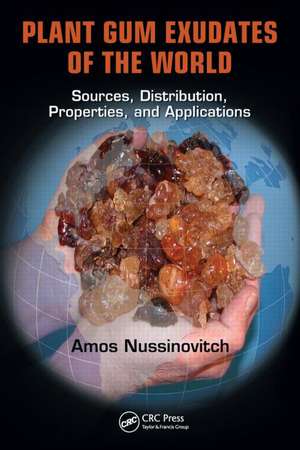Plant Gum Exudates of the World: Sources, Distribution, Properties, and Applications
Autor Amos Nussinovitchen Limba Engleză Hardback – 21 dec 2009
Each entry includes:
- Botanical name
- Common and vernacular gum names
- Geographical distribution information
- Appearance and color descriptions
- Water solubility information
- Chemical characteristics
- Structural features
- Physical and physicochemical properties
- Commercial availability
- Industrial and food applications
- Synonyms of and uses for the producing tree or shrub
Preț: 1164.93 lei
Preț vechi: 1636.76 lei
-29% Nou
Puncte Express: 1747
Preț estimativ în valută:
222.91€ • 233.21$ • 185.17£
222.91€ • 233.21$ • 185.17£
Comandă specială
Livrare economică 12-26 martie
Doresc să fiu notificat când acest titlu va fi disponibil:
Se trimite...
Preluare comenzi: 021 569.72.76
Specificații
ISBN-13: 9781420052237
ISBN-10: 1420052233
Pagini: 428
Ilustrații: 38 b/w images, 192 color images and 11 tables
Dimensiuni: 178 x 254 x 23 mm
Greutate: 1.07 kg
Ediția:1
Editura: CRC Press
Colecția CRC Press
ISBN-10: 1420052233
Pagini: 428
Ilustrații: 38 b/w images, 192 color images and 11 tables
Dimensiuni: 178 x 254 x 23 mm
Greutate: 1.07 kg
Ediția:1
Editura: CRC Press
Colecția CRC Press
Public țintă
ProfessionalCuprins
Role and Sources of Exudate Gums. Physiological Aspects of Polysaccharide Formation in Plants. Major Plant Exudates of the World. Minor Plant Exudates of the World. Food Applications of Plant Exudates. Gum Exudates in Water-Based Adhesives. Medical, Cosmetic and Biotechnological Uses of Gum Exudates. Analysis and Identification of Gum Exudates. Miscellaneous Uses of Plant Exudates.
Recenzii
"The catalogue begins with the widely used gum arabic, from the genus Acacia (Fabaceae) and gum tragacanth from Astragalus (Fabaceae) and Sterculia (Malvaceae), but later changes to ordering by region - Asiatic, New World and miscellaneous. Taxa are described in terms of, for example, their distribution in the world, the charactenstIcs of the plant and the exudate, and its commercial uses and economic importance. There are many photographs of plants and gums, mostly of high quality, and some reproduced fine drawings of plants."
—G. R. Squire, in The Journal of Experimental Agriculture, Vol. 46/4, 2010
"This book will surely become the definitive reference for the vast array of gums and resins of diverse origin which have been known from historical times and have continued to emerge over the years. The exudate-bearing trees are distributed all over the world, in different climates and continents. The various names by which they are known and the different classification systems adopted have presented a major problem to the student and researcher. Now we have a uniform classification system based on botanical taxonomy which have been checked and standardised to accord with the U.S. Department of Agriculture's Germoplasm Resource Information Network. It is a massive step forward for which countless researchers will thank the author."
—Glyn O. Phillips, Phillips Hydrocolloids Research Ltd, in Food Hydrocolloids, 2011
"The author reached his goal: this book is definitely the most complete work on the subject."
—Esther Katz, Institut de Recherche pour le Developpement Brasilia, in Economic Botany, Vol. 65, 2011
—G. R. Squire, in The Journal of Experimental Agriculture, Vol. 46/4, 2010
"This book will surely become the definitive reference for the vast array of gums and resins of diverse origin which have been known from historical times and have continued to emerge over the years. The exudate-bearing trees are distributed all over the world, in different climates and continents. The various names by which they are known and the different classification systems adopted have presented a major problem to the student and researcher. Now we have a uniform classification system based on botanical taxonomy which have been checked and standardised to accord with the U.S. Department of Agriculture's Germoplasm Resource Information Network. It is a massive step forward for which countless researchers will thank the author."
—Glyn O. Phillips, Phillips Hydrocolloids Research Ltd, in Food Hydrocolloids, 2011
"The author reached his goal: this book is definitely the most complete work on the subject."
—Esther Katz, Institut de Recherche pour le Developpement Brasilia, in Economic Botany, Vol. 65, 2011
Notă biografică
Dr. Amos Nussinovitch works in the Biochemistry and Food Science Department on the Robert H. Smith Faculty of Agriculture, Food and Environment of the Hebrew University of Jerusalem, where he leads a large group of researchers working on theoretical and practical aspects of hydrocolloids, including coating of cells and foods, special glues and exudates patches, water-soluble polymer uses in paper, exudates preparations in cosmetics and medicine, hydrocolloid uses in explosives, ink, and special cellular solids and biological carriers.
Descriere
Considered magicians of the ingredient world, gums (hydrocolloids) are used in a variety of food applications. They possess excellent thickening, binding, emulsifying, suspension, and viscosity properties. The first comprehensive reference produced on gums in 60 years, this work is organized by taxonomy. Each entry contains the botanical name and synonyms of the tree from which it is exuded, common names, geographic distribution, chemical characteristics and structural features, physical properties, and industrial and food applications. The uses of other parts of the trees from which the gums originate are also detailed. Entries are illustrated with color photos and line drawings.
